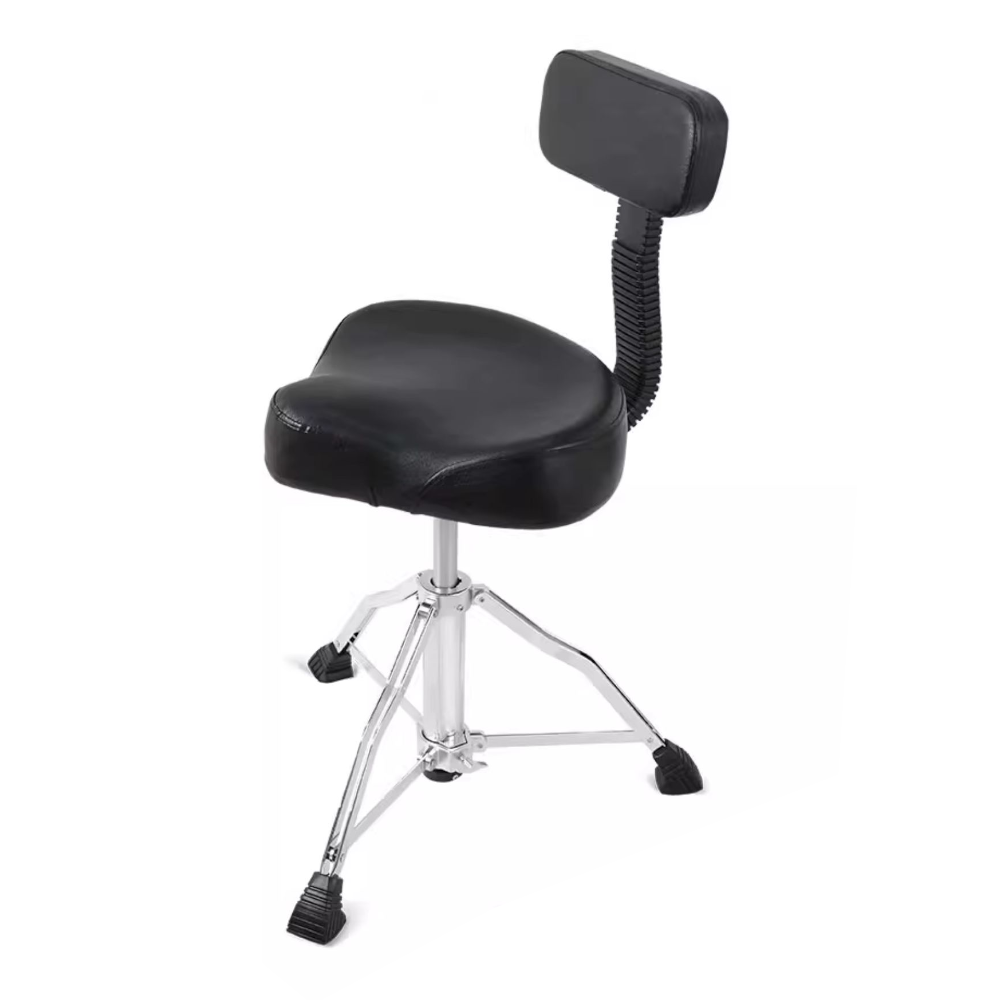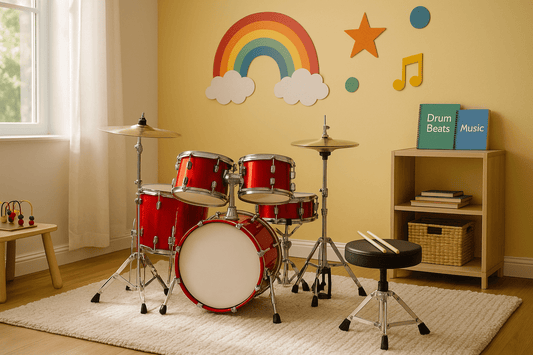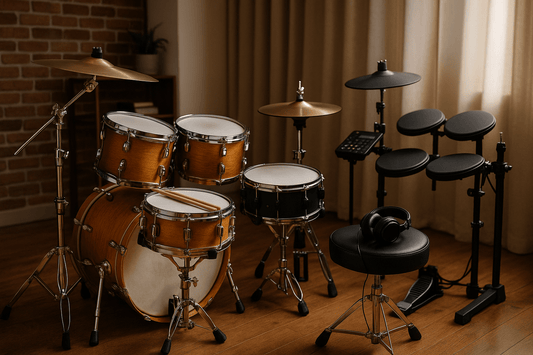Drummers spend hours sitting behind their kit, often without realizing the strain it puts on their lower back and spine. Whether you're a seasoned gigging pro or an enthusiastic beginner, investing in a drum throne with backrest is a game-changer—not just for comfort, but for your long-term health and performance. A throne with solid lumbar support keeps your spine aligned, reduces fatigue, and helps maintain better posture during those marathon sessions.
But with so many options out there, how do you choose the right drum chair with back support? In this guide, we’ll break down the physical benefits, essential features to look for, and review five top-tier drum thrones that deliver unbeatable support. Let’s get your posture right and your playing even tighter.
Why Back Support Matters for Drummers
The Physical Demands of Drumming
Drumming isn’t just music—it’s a full-body workout. Your arms, legs, and core are constantly engaged, and your back bears the brunt of your seated position. Unlike a casual chair, a drum throne needs to handle dynamic movement—twists, tilts, and weight shifts—all while keeping you balanced and stable.
Without proper support, the lower back takes on excess pressure, leading to tight muscles, soreness, and sometimes even long-term injuries like sciatica or herniated discs. A supportive throne mitigates these issues by distributing your body weight evenly and encouraging correct spinal alignment.
Especially during extended gigs or rehearsals, fatigue sets in fast without a well-designed seat. That’s why many pro drummers consider a quality throne just as important as their snare or cymbals. Comfort isn’t a luxury—it’s part of the performance.
How Poor Posture Affects Performance and Health
Poor posture can sneak up on you—especially if your drum chair doesn’t support the natural curve of your spine. Slouching reduces breathing capacity, affects timing, and limits your movement around the kit. Over time, these small issues compound, causing tight shoulders, neck stiffness, and chronic back problems.
Not to mention, bad posture directly affects your playing technique. Strained posture reduces your range of motion, makes foot control less precise, and slows down your hand speed. Worse yet, your muscles tire faster, and that directly impacts your stamina and fluidity on the drums.
That’s where a backrest-equipped throne comes in. It offers extra support that reinforces upright posture, reminding your body to stay aligned without having to think about it. It's not about leaning back and relaxing—it's about engaging your core, protecting your spine, and playing smarter.
Key Features to Look for in a Drum Throne with Backrest
Ergonomic Seat Design
Not all drum seats are created equal. Look for an ergonomic shape, ideally a saddle or hybrid design, which contours naturally to your body. Saddle seats help keep the hips open and reduce stress on the lumbar spine, promoting better circulation and comfort.
Some models also feature split-seat or spinal groove designs that minimize pressure on your tailbone and allow for longer playing sessions without numbness. Round seats may offer more mobility, but often lack the structured support needed for long sessions unless they’re well-padded and firm.
Seat size is another consideration. Larger, wider seats distribute your weight more evenly, which helps with comfort and balance—especially for drummers with a larger frame or those playing energetic genres like rock or metal.
Adjustable Backrest and Height Range
An effective backrest isn’t fixed—it’s adjustable. The best drum thrones let you set the height, angle, and distance of the backrest to align with your spine and upper back. This customizability ensures the support hits exactly where you need it, keeping your posture neutral and your body relaxed.
Height adjustment is also crucial. A throne should let your thighs rest slightly downward, keeping your feet flat on the pedals and your hips just above knee level. Most premium thrones offer spindle or hydraulic systems to dial in the perfect height.
Some models even offer backrests that move with your body or detach when not needed—making them ideal for both performance and portability. Don’t underestimate this feature. A poorly aligned backrest can be more of a nuisance than a help.
Cushioning, Stability, and Base Support
Comfort isn’t just about the backrest. The seat cushioning matters just as much. Look for memory foam or multi-layered padding that supports without sinking. Too soft, and you’ll sink out of alignment. Too hard, and you’ll feel sore before the first set ends.
A double-braced base and anti-slip rubber feet are must-haves. Stability keeps you confident in every movement, from double-kick runs to side-arm crashes. A throne that wobbles or shifts can throw off your balance and even lead to injury during high-energy play.
Also, don’t forget swivel functionality. Being able to rotate freely lets you move across your kit smoothly without twisting your spine—an underrated but essential element of good posture.
Top 5 Drum Thrones with Backrest Reviewed
1. Roc-N-Soc Nitro with Backrest
The Roc-N-Soc Nitro is a classic for a reason. It combines a comfortable saddle-style seat with a nitrogen gas shock absorber for ultra-smooth height adjustments. The contoured backrest provides excellent support and can be adjusted to match your posture preferences.
-
Seat Type: Saddle
-
Height Adjustment: Hydraulic
-
Best For: All-around use, especially rock and fusion players
-
Why It’s Great: Super durable, supportive, and perfect for long gigs.
2. Tama 1st Chair Ergo-Rider with Backrest
Tama’s 1st Chair Ergo-Rider blends the best of both worlds—a hybrid round-saddle seat with a molded ergonomic shape. The backrest is thick, padded, and easily adjustable, while the throne itself is engineered for hardcore touring conditions.
-
Seat Type: Hybrid (round/saddle)
-
Height Adjustment: Spindle
-
Best For: Heavy hitters and technical players
-
Why It’s Great: Excellent lumbar support and ultra-stable construction.
3. Gibraltar 9608MB Drum Throne
Affordable but not lacking in features, the Gibraltar 9608MB offers a solid round seat with thick foam padding and a detachable, height-adjustable backrest. It’s great for drummers who want comfort and support without breaking the bank.
-
Seat Type: Round
-
Height Adjustment: Spindle
-
Best For: Budget-conscious players who value comfort
-
Why It’s Great: Rugged, comfortable, and surprisingly versatile.
4. Tempo Gear T40 Ergonomic Drum Throne with Backrest
This Aussie-designed throne is a rising favorite. It features a wide, 3D-contoured ergonomic seat and a self-adaptive backrest that aligns naturally with your spine. With air pressure height adjustment and 360° rotation, it's tailor-made for comfort and adjustability.
-
Seat Type: Ergonomic, wide
-
Height Adjustment: Hydraulic (Air Pressure)
-
Best For: Posture-conscious drummers and studio sessions
-
Why It’s Great: Premium comfort, pro-level stability, great for posture.
5. Ahead Spinal G with Backrest
Known for its spinal groove design that eliminates pressure along the tailbone, the Spinal G is a game-changer. The backrest complements the ergonomic cut perfectly, providing targeted lumbar support and flexibility. It’s pricey—but worth every cent.
-
Seat Type: Split Saddle
-
Height Adjustment: Spindle
-
Best For: Advanced players with posture issues or back pain
-
Why It’s Great: Maximum relief, innovative design, superior build quality.
Comparison Table of Features and Specs
| Drum Throne | Seat Type | Backrest Type | Height Adjustment | Best For | Price Range |
|---|---|---|---|---|---|
| Roc-N-Soc Nitro | Saddle | Adjustable, padded | Hydraulic | All-around, long sessions | $639 |
| Tama 1st Chair Ergo-Rider | Hybrid (Round/Saddle) | Adjustable, firm | Spindle | Heavy hitters, pro gigs | $589 |
| Gibraltar 9608MB | Round | Detachable, padded | Spindle | Budget-conscious drummers | $249 |
| Tempo Gear T40 | Wide ergonomic | Self-adaptive | Hydraulic | Ergonomics, posture, studio players | $159 |
| Ahead Spinal G | Split saddle | Adjustable lumbar | Spindle | Posture correction, back relief | $509 |
This table helps you quickly compare the essential specs across the top five thrones. Whether you're a budget shopper or looking for advanced lumbar design, you can find the right fit based on your needs and play style.
How to Choose the Right Drum Chair with Back Support for You
Consider Your Playing Style and Body Type
Not all thrones work for every drummer. If you're a high-energy performer playing aggressive genres like rock or metal, you'll need a drum chair with a sturdy frame and tight backrest support. On the other hand, jazz or studio drummers who sit for longer, more controlled sessions might prefer a wider ergonomic seat with softer cushioning and breathable fabric.
Your body type also plays a major role. Taller drummers should ensure the throne offers higher seat adjustment. If you have a broader build, opt for a wide saddle or split-seat design to prevent pressure points. Some thrones are more accommodating than others, so don't assume a “one-size-fits-all” mentality when buying.
Budget vs. Performance Needs
Let’s face it—price can be a factor. While a high-end drum throne with advanced ergonomic support might be ideal, it’s not always feasible for every player. If you’re on a budget, go for models like the Gibraltar 9608MB or Tempo Gear T40 that still offer excellent support without the luxury price tag.
However, think of your throne as a long-term investment. You can swap out sticks and heads regularly, but a good throne can last you years—possibly a lifetime. When it comes to comfort, posture, and injury prevention, it's often worth stretching your budget.
Portability and Durability Considerations
If you’re a gigging drummer, portability becomes a big deal. Heavy thrones with backrests can be bulky to transport, especially if they don’t fold down easily or detach. Some models have removable backrests or collapsible legs, which make them easier to lug around between gigs and studios.
Also, look at durability—double-braced legs, solid welds, and thick seat posts are your best bet. Hydraulic models are convenient but may require maintenance after extensive use. Spindle thrones, while slightly slower to adjust, tend to be more rugged for constant road use.
Before buying, ask yourself:
-
Will I be setting this up frequently?
-
Do I need quick adjustability or max stability?
-
Will I use the backrest all the time, or only during long sessions?
Matching the throne to your lifestyle is just as important as comfort.
Drum Throne Setup Tips for Posture and Performance
Seat Height and Leg Positioning
This is where most drummers go wrong. Your throne height determines your hip-to-knee ratio, which directly affects your spine’s alignment. The golden rule? Sit high enough that your thighs angle slightly downward and your feet naturally rest flat on the pedals.
A seat that's too low can round your lower back and put stress on your spine. Too high, and your feet lose pedal control and strain your calves. Start by sitting on your throne, placing your feet on the pedals, and adjusting until your hips are about an inch above your knees.
If your drum throne has tilt options, use them to ensure your pelvis sits in a forward-neutral position. This engages your core and allows your backrest to support your lumbar zone without you leaning too far back.
Backrest Angle and Support Zone
Most drummers think of a backrest as something to lean on, but it should function more like a posture assistant. It should lightly touch your lower to mid-back, encouraging an upright stance without forcing it. You shouldn’t be slouching into it like a recliner—but using it as a guide for correct alignment.
Adjust the angle and depth of your backrest so that it supports you in your natural drumming position. Some thrones like the Tempo Gear T40 come with a self-adaptive design that moves slightly with your body, which is perfect for players who shift around the kit often.
Spend some time experimenting with small tweaks. Even a 1–2 inch adjustment in backrest height can make a huge difference in how your back feels after a long set.
Aligning the Throne with Your Kit Layout
Your throne isn’t just part of your posture—it affects your whole kit layout. Ideally, you want to sit at a central point that gives you equal reach to all drums and cymbals without twisting your torso. If you find yourself leaning too much in any direction, your throne might be positioned off-center.
Mark your perfect placement on a drum rug or use guide tape so it’s consistent every time you set up. Also, make sure your pedals align naturally with your feet from the throne's position. When everything’s aligned, your movements will feel smoother, and your posture will remain solid from beat one to beat one hundred.
Where to Buy Quality Drum Thrones with Backrests
Top Online Platforms and Retailers
Finding a reliable place to buy your drum throne is just as important as choosing the right model. Fortunately, there are several trusted online platforms that stock drum chairs with back support across a range of prices and features.
-
Store DJ (Australia) – One of the most trusted music gear retailers offering a wide variety of thrones from top brands. They frequently have sales and offer reliable, fast shipping across Australia.
-
Musos Corner – Based in Newcastle but ships Australia-wide, this retailer carries high-quality thrones with great customer support and a price match guarantee.
-
Tempo Gear – Specializing in ergonomic drum stools, Tempo Gear has become a go-to platform in Australia for premium, posture-friendly drum thrones. Their T40 and T20 models offer excellent back support at competitive prices with fast shipping.
-
Reverb and eBay Australia – Great for finding used or hard-to-get models. Just be sure to check seller ratings and warranty availability when buying second-hand.
Shopping online gives you access to reviews, specs, and competitive prices—but always check return policies and warranty coverage before finalizing your order.
What to Check Before Purchasing
Before buying your throne, double-check:
-
Backrest adjustability – Is it fixed or adjustable?
-
Seat size and material – Will it fit your body and comfort preferences?
-
Height range – Does it suit your leg length and pedal setup?
-
Weight capacity – Is it rated for your build and performance needs?
-
Return policy and warranty – Can you return it if it doesn’t work out?
If possible, test the throne in person at a local store or demo location. Comfort is incredibly subjective, and your ideal fit may surprise you.
Maintenance and Longevity of Your Drum Throne
Regular Cleaning and Inspection
A well-maintained drum throne can last for years, even with daily use. Basic cleaning goes a long way—especially if you’re sweating on it after long sessions or using it on dusty stages.
-
Wipe down the seat with a damp cloth after each session.
-
Avoid harsh cleaners—stick to mild soap and water or a gentle leather/fabric cleaner, depending on the material.
-
Inspect hardware monthly for loose bolts, worn joints, or cracked feet.
For fabric or mesh seats, consider using a seat cover or cushion protector to reduce wear and tear. Vinyl and leather seats benefit from occasional conditioning to prevent cracking.
Replacing Worn Components
Eventually, even the best thrones may need new parts. Common replaceable items include:
-
Backrest mounts and brackets
-
Seat cushions
-
Rubber feet or leg caps
-
Hydraulic or spindle systems
Most reputable brands and retailers—like Tempo Gear, Tama, or Gibraltar—offer spare parts. Replacing a worn seat cushion or tightening a wobbling spindle is much cheaper than buying a whole new throne.
Just make sure any replacement is compatible with your specific model. Keep your throne’s box and manual for easy part reference.
Conclusion
When it comes to drumming, posture and comfort aren’t optional—they’re critical. A drum throne with backrest supports your spine, boosts your endurance, and elevates your entire playing experience. Whether you're dealing with back pain, logging long practice hours, or just want to feel solid behind the kit, investing in the right throne pays off in both the short and long run.
From the legendary Roc-N-Soc Nitro to the ergonomically advanced Tempo Gear T40, there's a back-supported drum chair for every style, budget, and body type. Take the time to test, adjust, and refine your setup. Your posture, health, and groove will all benefit.
Remember: your throne is your foundation. Build it right, and everything else follows.
FAQs
1. Are drum thrones with backrests better for beginners?
Yes, especially for beginners learning proper posture and body alignment. A backrest helps reinforce good habits early and reduces fatigue during long practice sessions.
2. Can a backrest help with lower back pain while drumming?
Absolutely. A properly positioned backrest provides lumbar support, reduces spinal strain, and encourages healthy posture—key for preventing or relieving lower back pain.
3. What’s the difference between saddle and round seats?
Saddle seats offer better hip alignment and weight distribution, ideal for posture and comfort. Round seats provide more mobility and are often preferred for fast, dynamic play styles.
4. Is a fixed or adjustable backrest better?
Adjustable backrests are generally better. They let you customize the height and angle of support, ensuring it aligns perfectly with your lower back for maximum comfort.
5. Are there foldable options for travel-friendly thrones?
Yes, many thrones have removable or foldable backrests, and some models are designed with portability in mind. Always check the product specs for travel features if you're a gigging drummer.




